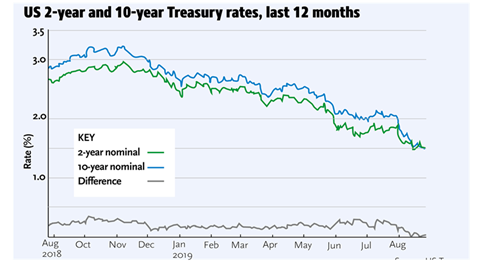Despite jitters in the bond market, where yields on Treasury paper inverted for the first time in years in mid-August, Europe’s real estate industry remains resilient, experts say.

August has a habit of springing surprises in financial markets: remember the eurozone debt crisis reaching boiling point in August 2011, sending equities plunging on fears Greece would crash out of the EU?
August 2019 has thrown its own googlie: in the form of falling yields on longer maturity global bonds which is being interpreted by commentators as heightened investor fear of recession.
In mid-August, the expansion in the number of bonds paying ever-lower interest moved to longer term debt, notably in the US and the UK, and resulted in inversion of the yield curve. That is to say, yields on longer-maturity government debt, the safest haven of all, fell below shorter term bond yields.
First, America’s 10-year Treasury yield fell below the two-year Treasury return; then the yield on 30-year US government bonds fell below 2% for the first time. On 14 August after UK inflation jumped above the Bank of England’s target and with Brexit looming, the UK’s two-year and 10-year curve inverted, for the first time since the financial crash in 2008.
Should the real estate industry be worried when ultra-low interest rates and associated low bond yields have been good for the asset class so far? Investors hungry for yield have turned to the sector and to other alternative assets, particularly targeting long-income properties as a proxy for bonds, and with the option of boosting cash-on-cash yields relatively higher still by borrowing at record cheap levels.
The problem will come if the fear of a global economic slump which caused the August rush into longer maturity government debt comes true.
‘There’s clearly quite a lot of concern going around,’ says Neil Blake, CBRE’s EMEA chief economist and head of forecasting, who believes the release on 14 August of Germany’s negative Q2 2019 GDP figure of -0.1% tipped the scales for bond investors already spooked by the US-China trade wars.
Two-speed economy
However, he argues that Germany’s figure was negative because it has a big manufacturing sector and the economic data coming out around the world is quite mixed. ‘What we seem to have almost everywhere is a sort of two-speed economy situation where manufacturing is struggling and services are doing quite well.’
He sees no signs yet of services following manufacturing down - with the obvious exception of retail, ‘but it’s not the economy but other things going on in retail...Consumer confidence is pretty high everywhere; unemployment is low; and we’ve started to get positive - if quite modest - wage growth in a lot of countries, including the UK, Germany and the US.’
He points to the change everywhere in services with the rise of tech and says this is fundamental for real estate because most investible property is linked to the service sector, not to manufacturing.
In Europe, he continues: ‘You’ve got this situation where the figures for office demand are not just holding up, but doing very well. There is something going on and it is obviously the tech industry driving it. So that’s the two-speed economy: manufacturing versus services; cities versus the rest. The bit that is driving commercial property is actually very resilient at the moment and shows no sign of changing.’
Others are also sanguine. Zachary Gauge, European real estate analyst at UBS Asset Management, says the bank has not changed its forecast assumptions to include a US recession ‘just because the yield curve has inverted’, although it recognises economic environments are weakening.
Gauge highlights the positives for real estate investors, particularly of limited development. ‘Because the supply response across Europe has been so limited over the past decade, although weakened economic growth limits the potential for stronger rental growth, the lack of supply means that rental growth is likely to stay positive, particularly at the better quality end of the market.’
He adds that, anecdotally, over the past few months ‘we have seen transaction yields on core and even some core-plus assets drop below levels we thought were realistic. Typically the floor for a prime office in Europe had been around the 3% mark but deals for genuinely prime buildings in Munich, Berlin, Paris and even Amsterdam are now going through this level.’ And these are buildings without any reversionary potential.









